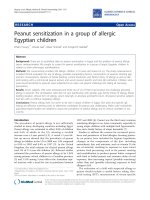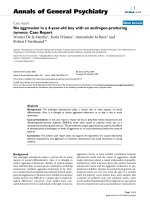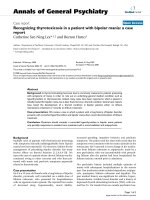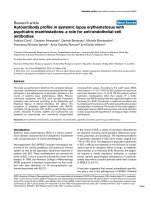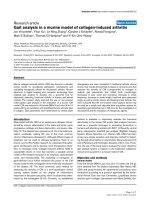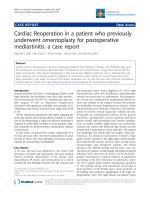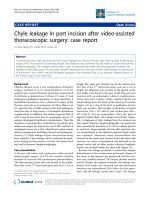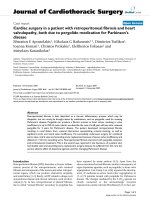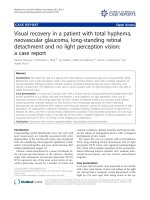Báo cáo y học: " Multifocal hepatoblastoma in a 6-month-old girl with trisomy 18: a case report" ppsx
Bạn đang xem bản rút gọn của tài liệu. Xem và tải ngay bản đầy đủ của tài liệu tại đây (823.26 KB, 4 trang )
Case report
Open Access
Multifocal hepatoblastoma in a 6-month-old girl with trisomy 18:
a case report
Lidija Kitanovski
1
*, Zdenka Ovcak
2
and Janez Jazbec
1
Addresses:
1
University Medical Centre Ljubljana, Department of Pediatrics, Hematooncology Division, Vrazov trg 1, 1000 Ljubljana, Slovenia
and
2
Institute of Pathology, Medical Faculty, University of Ljubljana, Korytkova 2, 1000 Ljubljana, Slovenia
Email: LK* - ; ZO - ; JJ -
* Corresponding author
Received: 20 October 2008 Accepted: 22 January 2009 Published: 23 June 2009
Journal of Medical Case Reports 2009, 3:8319 doi: 10.4076/1752-1947-3-8319
This article is available from: />© 2009 Kitanovski et al; licensee Cases Network Ltd.
This is an Open Access article distributed under the terms of the Creative Commons Attribution License (
/>which permits unrestricted use, distribution, and reproduction in any medium, provided the original work is properly cited.
Abstract
Introduction: Edward’s syndrome (trisomy 18) is a rare entity with a reported incidence of 1/3000
to 1/7000 births. Less than 10% of patients survive beyond the first year of life, which may influence
the fact that malignant tumors are rarely reported in association with this syndrome.
Case presentation: The authors report a rare case of a 6-month-old girl with trisomy 18 and
multifocal hepatoblastoma. The course of the disease, autopsy results and review of the literature are
presented.
Conclusion: Our case represents the seventh published case of hepatoblastoma in a patient with
trisomy 18. All of the seven published cases were women, possibly due to the high preponderance of
females among the children with Edward’s syndrome and longer survival of females with trisomy 18
compared to males. Since both trisomy 18 and hepatoblastoma are rare conditions, the probability
that a child with trisomy 18 will independently develop a hepatoblastoma is very low. Therefore, we
believe that the existence of these cases in children with trisomy 18 indicates a significant association.
It can be assumed that trisomy 18 potentiates the development of hepatoblastoma. Careful clinical
and post-mortem studies are needed to recognize the real frequency of hepatoblastoma in children
with trisomy 18, who might die from different causes with unrecognizable hepatoblastoma.
Introduction
Edward’s syndrome (ES) was first recognized as a specific
entity in 1960 by the discovery of the extra 18 chromo-
some in babies with a particular pattern of malformations
[1]. Children with trisomy 18 may have intrauterine
growth retardation, microcephaly, short stature, mental
retardation, cranio-facial abnormalities such as a small
face, prominent occiput, short palpebral fissures, small
mouth; limb abnormalities including overlapping fingers,
camptodactyly and nail hypoplasia; congenital heart
disease, omphalocele, horseshoe kidney, hypertonia, and
short sternum. It has been reported that the incidence
of ES is 1 in 3000 to 7000 births [2,3] and that survival
beyond infancy is unusual [2,4]. Less than 10% survive the
Page 1 of 4
(page number not for citation purposes)
first year [2,4]. There is a 3:1 preponderance of females to
males [5]. Malignant tumors are infrequently reported in
ES, perhaps due to high early mortality.
Hepatoblastoma (HB) sometimes occurs in patients with
congenital malformations [6], particularly in Beckwith-
Wiedemann syndrome. It is a rare tumor of infancy and
childhood with an annual incidence rate of approximately
1.8 per million in children less than 15 years of age [7].
The majority of HB are diagnosed before age two in
otherwise normal children and there is a 1.4:1 to 2:1
predominance in males [6].
We present a child with ES who developed HB at the age of
6 months.
Case presentation
A female, Caucasian, newborn girl was born to a 28-year-old
mother after her first pregnancy at 38 weeks of gestation.
The pregnancy was uneventful, except for colpitis, until the
29th gestational week when intrauterine growth retardation
was noticed. The infant birth weight was 1630 g, birth
length was 43 cm, and head circumference was 32.5 cm. The
family history was unremarkable. The child had prominent
occiput, micrognathia, high palate, low-set ears, overlapping
fingers of both hands, bilateral preauricular adnexes and
a red pedunculated tumor on the left cheek, diagnosed as
a hamartoma. Hypotonia, absent swallowing reflex and
abnormal spontaneous movements were observed. Chro-
mosome analysis of the peripheral blood cells revealed
47,XX,+18 chromosome. Echocardiography and abdominal
ultrasound examination were normal, while the ultrasound
of the head revealed agenesis of the corpus callosum.
Due to respiratory failure after birth, she was artificially
ventilated for 2 weeks. Thereafter she was nursed at home,
nourished through a gastrointestinal tube and her clinical
course was uneventful. At the age of 6 months, after she
had been treated for a urinary tract infection, hepatomegaly
was noticed. Abdominal ultrasound revealed three well-
defined hepatic masses. The largest one was 8.3 × 5.6 ×
9.6 cm in size, and the two smaller masses were approxi-
mately 3.2 and 3.7 cm in size. Only a minority of the liver
parenchyma appeared normal. Hepatoblastoma was con-
firmed by fine needle aspiration biopsy and an increased
level of a-fetoprotein (51542 IU/mL). Pulmonary X-ray
was normal. The infant was not treated for the tumor in
accordance with the parents’ decision. She was nursed at
home and only analgesic drugs were given.
One month later, she was admitted to hospital due to
restlessness, vomiting and cough for the previous 4 days.
She was in pain, febrile, icteric and protected her left arm.
Hypercalcemia (calcium 4.5 mmol/L) and fracture of the
left humerus were observed. She was treated with
intravenous bisphosphonates, analgesics and the left arm
was immobilized. In the following hours, she became
progressively dyspnoic and died on the next day.
At autopsy, the liver (741 g) was almost completely
overgrown with a multicentric tumor. The largest mass
measured10×9×8cm(Figure1).Thehistopathologic
diagnosis was epithelial HB - fetal type with typical
histologic appearance (Figure 2). In the field of the humerus
fracture, no tumorous tissue was found on microscopic
examination. D isseminated microscopic intravascular
coagulation was observed in the lungs and kidneys.
Neuropathologic autopsy revealed polymicrogyria, atrophy
of the cerebellum and white matter, hypoplasia of the
corpus callosum, dysplasia of the hippocampus, atrophic
pontocerebellar connections, dysplasia of the lower olivary
nucleus typical of trisomy 18 and atrophic pyramids in the
medulla oblongata. No additional abnormalities of the
heart, lungs, kidneys, suprarenal glands and gut were found.
Discussion
Neoplasias are uncommon in ES, possibly due to the high
mortality in the first year of life. Nevertheless, there are
reports of one neurogenic tumor [8] and at least six Wilms
tumors, in children with ES [9-12].
Congenital abnormalities have also been recognized in
patients with HB [11-13] which, after Wilms tumor, is the
second most common tumor associated with congenital
anomalies.
Figure 1. A multicentric lobulated liver tumor involves
almost the entire parenchyma. Two tumor nodules clearly
separated from each other are visible in the cross-section of
the liver at autopsy.
Page 2 of 4
(page number not for citation purposes)
Journal of Medical Case Reports 2009, 3:8319 />Hepatoblastoma has been documented to be related to
Beckwith-Wiedemann syndrome, hemi-hypertrophy [13]
and Prader-Willi syndrome [14]. Moreover, six cases of HB
in children with trisomy 18 have been published since
1987, when Dasouki and Barr reported the first case,
which was presumed to be HB [15-20]. The last review of
published cases was carried out by Maruyama et al. [20].
All of the cases were girls, and half of the cases were older
than 1 year at the time of recognition of HB. Five of them
had karyotype 47,XX,+18 [15-17,19,20], and in another
one [18], chromosomal analysis of peripheral blood
culture showed mosaic trisomy 47,XX,+18/46,XX (5:1).
There is another case mentioned by Bove et al. [15]. It can
be concluded that it refers to a 1-year-old boy, mosaic for
trisomy 18. Gut abnormalities were present in three of the
patients (malrotation of the gut in all three, ectopic
pancreas in two, omphalocele in one) [15,17,20], while
morphological abnormalities of the liver had not been
observed, except for a deep cleft between the hepatic lobes
in one patient [15]. Apart for neurologic abnormalities,
no visceral irregularities were found in our patient. In three
of the c ases, where t he t umors w ere c ytogenetically analyzed,
excessive chromosome 18 was found in the tumor tissue
[15,18,19]. Epithelial type HB with different histological
patterns was diagnosed in all patients [15,17-20].
The liver tumors were resected in three cases; two patients
were alive with no evidence of recurrence at 3 and 4 years
of age [18,19], the other died due to widespread bone
metastases [15]. Among the untreated patients, HB was an
incidental finding at autopsy in one of two patients who
died from cardiac failure [17,20], while our patient and the
one with presumed HB [16] died due to progression of
malignant disease.
Conclusion
Our case represents the seventh published case of HB in
trisomy 18 and, together with the unpublished case
mentioned by Bove et al. [15], represents the eighth
known case of HB in children with trisomy 18. All of the
seven published cases were females, possibly due to the
high preponderance of females among the children with
ES and longer survival of females w ith trisomy 18
compared to males [4]. Since both trisomy 18 and HB
are rare conditions, the probability that a child with
trisomy 18 will independently develop a HB is very low.
Therefore, we believe that the existence of these cases in
children with trisomy 18 indicates a significant associa-
tion. It can be assumed that trisomy 18 potentiates the
development of HB. Careful clinical and post-mortem
studies are required to recognize the real frequency of HB
in children with trisomy 18, who might die from different
causes with unrecognizable HB.
Abbreviations
Trisomy 18, Edward’s syndrome; HB, Hepatoblastoma.
Consent
Written informed consent was obtained from the parents
for publication of this case report and any accompanying
images. A copy of the written consent is available for
review by the Editor-in-Chief of this journal.
Competing interests
The authors declare that they have no competing interests.
Authors’ contributions
LK and JJ were treating physicians and wrote the manu-
script. ZO did the autopsy and described autopsy results,
pathological description and did the figures.
References
1. Edwards HJ, Harnden DG, Cameron AH, Crosse WM, Wolff OH:
A new trisomic syndrome. Lancet 1960, 1:787-790.
2. Root S, Carey JC: Survival in trisomy 18. Am J Med Genet 1994,
49:170-174.
3. Taylor A: Autosomal trisomy syndrome; a detailed study of 17
cases of Edward’s syndrome. J Med Genet 1968, 5:227-252.
4. Rasmussen SA, Wong LY, Yang Q, May KM, Friedman JM: Popula-
tion-based analyses of mortality in trisomy 13 and trisomy 18.
Pediatrics 2003, 111:777-784.
5. Jones KL: Smith’s Recognizable Patterns of Human Malformation. 4th
edition. Philadelphia, PA: WB Saunders; 1988.
6. Lack EE, Neave C, Vawter GF: Hepatoblastoma. A clinical and
pathologic study of 54 cases. Am J Surg Pathol 1982, 6:693-705.
7. Smith MA, Gloeckler Ries LA: Childhood cancer: incidence,
survival, and mortality.InPrinciples and Practice of Pediatric
Oncology. 4th edition. Edited by Pizzo PA, Poplack GD. Philadelphia,
PA: Lippincott Williams; 2002:1-12.
8. Robinson MG, McQuorquodale MM: Trisomy 18 and neurogenic
neoplasia. J Pediatr 1981, 99:428-429.
Figure 2. Fetal type tumor cells resembling hepatocytes are
arranged in trabeculae and plates. Foci of extramedullary
hematopoiesis are also present. Hematoxylin and eosin
stain, ×40.
Page 3 of 4
(page number not for citation purposes)
Journal of Medical Case Reports 2009, 3:8319 />9. Olson JM, Hamilton A, Breslow NE: Non-11 p constitutional
chromosome abnormalities in Wilms tumor patients. Med
Pediatr Oncol 1995, 24:305-309.
10. Geiser CF, Schindler AM: Long survival in a male with trisomy
18 and Wilms tumor. Pediatrics 1969, 44:111-115.
11. Karayalcin C, Shanske A, Honigman R: Wilms tumor in a 13 year
old girl with trisomy 18. Am J Dis Child 1981, 135:665-667.
12. Anderson CE, Punnett HH, Huff V, de Chadarevian JP: Character-
ization of a Wilms tumor in a 9-year old girl with trisomy 18.
Am J Med Genet 2003, 121:52-55.
13. Tomlinson GE, Finegold MJ: Tumors of the liver.InPrinciples and
Practice of Pediatric Oncology. 4th edition. Edited by Pizzo PA,
Poplack DG. Philadelphia, PA: Lippincott Williams; 2002:847-864.
14. Hashizume K, Nakajo T, Kawarasaki H, Iwanaka T, Kanamori Y,
Tanaka K, Utuki T, Mishina J, Watanabe T: Prader-Willi syndrome
with del(15)(q11,q13) associated with hepatoblastoma. Acta
Paediatr Jpn 1991, 33:718-722.
15. Bove KE, Soukup S, Ballard ET, Ryckman F: Hepatoblastoma in a
child with trisomy 18: cytogenetics, liver anomalies, and
literature review. Pediatr Pathol Lab Med 1996, 16:253-262.
16. Dasouki M, Barr M Jr: Trisomy 18 and hepatic neoplasia. Am J
Med Genet 1987, 27:203-205.
17. Mamlok V, Nichols M, Lockhart L, Mamlok R: Trisomy 18 and
hepatoblastoma. Am J Med Genet 1989, 33:125-126.
18. Tanaka K, Uemoto S, Asonuma K, Katayama T, Utsunomiya H,
Akiyama Y, Sasaki MS, Ozawa K: Hepatoblastoma in a 2-year-old
girl with trisomy 18. Eur J Pediatr Surg 1992, 2:298-300.
19. Teraguchi M, Nogi S, Ikemoto Y, Ogino H, Kohdera U, Sakaida N,
Okamura A, Hamada Y, Kobayashi Y: Multiple hepatoblastomas
associated with trisomy 18 in a 3-year-old girl. Pediatr Hematol
Oncol 1997, 14:463-467.
20. Maruyama K, Ikeda H, Koizumi T: Hepatoblastoma associated
with trisomy 18 syndrome: A case report and a review of the
literature. Pediatr Int 2001, 43:302-305.
Page 4 of 4
(page number not for citation purposes)
Journal of Medical Case Reports 2009, 3:8319 />Do you have a case to share?
Submit your case report today
• Rapid peer review
• Fast publication
• PubMed indexing
• Inclusion in Cases Database
Any patient, any case, can teach us
something
www.casesnetwork.com
